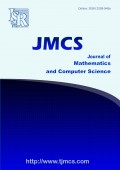Screening osteoporosis in elderly using a new two inertial projective forward-backward splitting algorithm
Authors
Ch. Mekkrua
- Demonstration School, University of Phayao, Phayao 56000, Thailand.
P. Peeyada
- Department of Mathematics, School of Science, University of Phayao, Phayao 56000, Thailand.
W. Cholamjiak
- Department of Mathematics, School of Science, University of Phayao, Phayao 56000, Thailand.
W. Liawrungrueang
- Department of Orthopaedics, School of Medicine, University of Phayao, Phayao 56000, Thailand.
Abstract
In this work, we propose a new two inertial projective forward-backward splitting algorithm for approximating the solution of the variational inclusion problem in real Hilbert spaces. We prove weak convergence of the sequence generated by our proposed iterative algorithm. Moreover, we also provide an application to predict osteoporosis in the elderly using a dataset from the Harvard Dataverse. The comparison of algorithm performance is calculated using accuracy, precision, recall, and F1-score. Our algorithm's performance is higher than other comparable algorithms. As a result, our algorithm is an effective classification technique for identifying osteoporosis.
Share and Cite
ISRP Style
Ch. Mekkrua, P. Peeyada, W. Cholamjiak, W. Liawrungrueang, Screening osteoporosis in elderly using a new two inertial projective forward-backward splitting algorithm, Journal of Mathematics and Computer Science, 37 (2025), no. 2, 190--200
AMA Style
Mekkrua Ch., Peeyada P., Cholamjiak W., Liawrungrueang W., Screening osteoporosis in elderly using a new two inertial projective forward-backward splitting algorithm. J Math Comput SCI-JM. (2025); 37(2):190--200
Chicago/Turabian Style
Mekkrua, Ch., Peeyada, P., Cholamjiak, W., Liawrungrueang, W.. "Screening osteoporosis in elderly using a new two inertial projective forward-backward splitting algorithm." Journal of Mathematics and Computer Science, 37, no. 2 (2025): 190--200
Keywords
- Variational inclusion problem
- osteoporosis
- elderly
- inertial method
- data classification
MSC
References
-
[1]
M. Akil, R. Saouli, R. Kachouri, Fully automatic brain tumor segmentation with deep learning-based selective attention using overlapping patches and multi-class weighted cross-entropy, Med. Image Anal., 63 (2020),
-
[2]
M. Al-Qurashi, S. Rashid, F. Jarad, E. Ali, R. H. Egami, Dynamic prediction modelling and equilibrium stability of a fractional discrete biophysical neuron model, Results Phys., 48 (2023), 11 pages
-
[3]
Q. H. Ansari, I. V. Konnov, J. C. Yao, Existence of a solution and variational principles for vector equilibrium problems, J. Optim. Theory Appl., 110 (2001), 481–492
-
[4]
M. Bianchi, N. Hadjisavvas, S. Schaible, Vector equilibrium problems with generalized monotone bifunctions, J. Optim. Theory Appl., 92 (1997), 527–542
-
[5]
P. L. Combettes, V. R.Wajs, Signal recovery by proximal forward-backward splitting, Multiscale Model. Simul., 4 (2005), 1168–1200
-
[6]
J.-Y. Fu, Generalized vector quasi-equilibrium problems, Math. Methods Oper. Res., 52 (2000), 57–64
-
[7]
K. Goebel, W. A. Kirk, Topics in metric fixed point theory, Cambridge University Press, Cambridge (1990)
-
[8]
L. He, Bone mineral density, Harvard Dataverse, (2022)
-
[9]
O. S. Iyiola, Y. Shehu, Convergence results of two-step inertial proximal point algorithm, Appl. Numer. Math., 182 (2022), 57–75
-
[10]
E. N. Khobotov, Modification of the extra-gradient method for solving variational inequalities and certain optimization problems, USSR Comput. Math. Math. Phys., 27 (1987), 120–127
-
[11]
P.-L. Lions, B. Mercier, Splitting algorithms for the sum of two nonlinear operators, SIAM J. Numer. Anal., 16 (1979), 964–979
-
[12]
G. López, V. Martín-Márquez, F. Wang, H.-K. Xu, Forward-backward splitting methods for accretive operators in Banach spaces, Abstr. Appl. Anal., 2012 (2012), 25 pages
-
[13]
D. A. Lorenz, T. Pock, An inertial forward-backward algorithm for monotone inclusions, J. Math. Imaging Vis., 51 (2015), 311–325
-
[14]
D. T. Luc, N. X. Tan, Existence conditions in variational inclusions with constraints, Optimization, 53 (2004), 505–515
-
[15]
A. Moudafi, M. Oliny, Convergence of a splitting inertial proximal method for monotone operators, J. Comput. Appl. Math., 155 (2003), 447–454
-
[16]
E. U. Ofoedu, Strong convergence theorem for uniformly L-Lipschitzian asymptotically pseudocontractive mapping in real Banach space, J. Math. Anal. Appl., 321 (2006), 722–728
-
[17]
Z. Opial, Weak convergence of the sequence of successive approximations for nonexpansive mappings, Bull. Amer. Math. Soc., 73 (1967), 591–597
-
[18]
T. Seangwattana, K. Sombut, A. Arunchai, K. Sitthithakerngkiet, A modified Tseng’s method for solving the modified variational inclusion problems and its applications, Symmetry, 13 (2021), 17 pages
-
[19]
N. X. Tan, On the existence of solutions of quasivariational inclusion problems, J. Optim. Theory Appl., 123 (2004), 619–638
-
[20]
L. A. Tuan, P. H. Sach, Existence of solutions of generalized quasivariational inequalities with set-valued maps, Acta Math. Vietnam., 29 (2004), 309–316
-
[21]
N. W. S. Wardhani, M. Y. Rochayani, A. Iriany, A. D. Sulistyono, P. Lestantyo, Cross-validation metrics for evaluating classification performance on imbalanced data, In: 2019 international conference on computer, control, informatics and its applications (IC3INA), IEEE, (2019), 14–18

